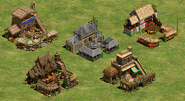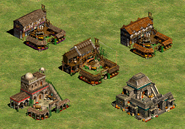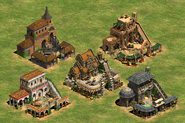| This article is about the building in Age of Empires II. For similar buildings in other games of the series, see Market. |
Template:AoEIIBuilding
| “ | Used to buy and sell resources, trade with other players by land, and research trade improvements. | ” |
| —Age of Empires II description | ||
The Market is an economic building in Age of Empires II that becomes available once the Feudal Age is reached and a Mill is built.
Markets enable trade with Trade Carts, making them extremely important in later stages of team games.
Markets can also be used to research trade-related technologies, and to trade gold for other resources.
Tactics and placement
Trading
Markets make an essential part on economy especially in team games as they provide an unlimited source of gold, through trading.
The equation for gold received while trading at other Markets is quadratic. The farther away the Market is, the more gold the Trade Carts return. The productivity increases with the distance, so it is always worth it to build Markets far away from other Markets even though the Trade Carts take longer to reach their destination.
When trading with allies, is important to know which Markets are better defended to prevent losing trade units. It is also recommended to protect trade routes with military units or defensive structures. If Trade Carts must travel through a wall, it is important to remember to keep the Gate open at all times to avoid losing Trade Carts, because when they reach a closed Gate, they will take another way to reach their destination even if the Gate is opened a short time after they reached it. Often, Trade Carts are lost because of that since the route they then choose is likely to be dangerous.
Trading can also be established with neutral and hostile players' Markets too, emulating thus the real life practice of smuggling. While this can be surprisingly efficient when trading with defeated players (especially in campaign scenarios), it is ill-advised when the player in question is still active, as they might kill the Trade Carts.
Exchange of resources
Markets are also important because a player can interchange their own resources. This can greatly help to jump through Ages or to overcome a temporary shortage of a particular resource.
The Market exchange rates are universal for every player. Every transaction changes the base exchange rate for the resource by +/-2 for buying and selling, respectively. Base prices are capped by min. 20 and max. 9999. The actual prices are also influenced by the 30% trading fee (15% with Guilds researched), which gets added/subtracted from the exchange rate. Food and wood base prices start off at 100, while stone is set 130 (or 15 clicks up).
The Saracens have a trading bonus that lowers their interchange tax to 5%. This also allows them to reach the Castle Age sooner than other civilizations an perform a Monk rush.
'Bottoming out' a resource requires selling 4,000 food or wood and can be very profitable for the first player to do so. With the standard 30% commodity trading fee, the first player can earn 1,722 gold from this. With Guilds (15% fee), the player can earn 2,091 gold. Finally, the Saracen civilization bonus (5% fee) means that they can earn 2,337 gold. Selling stone is even more profitable but is uncommon to sell.
Trade Cart gold
Trade routes should always be made as long as possible, as the increase in gold for Markets placed further apart is greater than the increase in time taken for a Trade Cart to complete the journey. The exact equation for gold received from trading is:
where is the number of tiles along any edge of the map, and is roughly the Euclidean distance between the Markets, or exactly:
where and are the distances between the Markets in either axis-aligned direction, measured from the center of each Market.
Note that the 0.46 in front of the first expression for Trade Cart gold is actually calculated as by the game, where 2 is a constant, and the other two terms depend on the Trade Cart speed and whether the player has a Spanish ally - but can in general also be treated as constants.
Trainable units and technologies

|
→ | 
|
→ | 
|
→ | 
|

|

| |||||

|
→ | 
|
||||

|
→ | 
|
Further statistics
| Building strengths and weaknesses | |
|---|---|
| Strong vs. | Nothing |
| Weak vs. | Everything |
| Upgrades | |
| Hit points | |
| Armor | |
| Line of Sight | |
| Conversion defense | |
| Construction speed | |
| Other | |
Civilization bonuses
- Burmese: Researching Faith is 50% cheaper.
- Byzantines: Markets have +20%/+30%/+40% HP in the Feudal/Castle/Imperial Age. Town Watch is free.
- Chinese: Technologies that benefit Markets are 10%/15%/20% cheaper in the Feudal/Castle/Imperial Age.
- Khmer: Markets don't require a Mill.
- Malians: Markets are 15% cheaper.
- Persians: Researching Town Watch and Town Patrol is 10%/15%/20% faster in the Feudal/Castle/Imperial Age.
- Saracens: Market trade cost is only 5%. Markets are 43% cheaper.
- Spanish: Markets are built 30% faster.
Team bonuses
- A team containing Malians: Researching Masonry, Architecture, and Treadmill Crane is 80% faster.
Changelog
The Age of Kings
- Markets always have 2100 HP.
The Conquerors
The Forgotten
- Market HP staggered: 1800/2100/2100 in the Feudal/Castle/Imperial Age.
- Saracens: Markets now are 43% cheaper.
Trivia
- The maximum cost for purchasing 100 of any resource from the Market is 12,999 gold and the maximum selling price of 100 of any resource is 6,999 gold. These values can be reached by buying 330,000 of any resource other than stone, assuming that the player has enough gold to make these purchases.
History
| “ | As the Dark Ages gave way to better economic conditions, the exchange of produce and craft goods increased. Towns of all sizes set aside an area for a market where farmers and tradesmen could set up stalls for selling their merchandise. One or more days each week were designated market days and became the social highlight of the typical workweek. The market was also a place for the exchange of ideas, entertainment (bards, acrobats, musicians), and the spreading of news. | ” |
Gallery
Video overview
Template:Buildings AoE2














